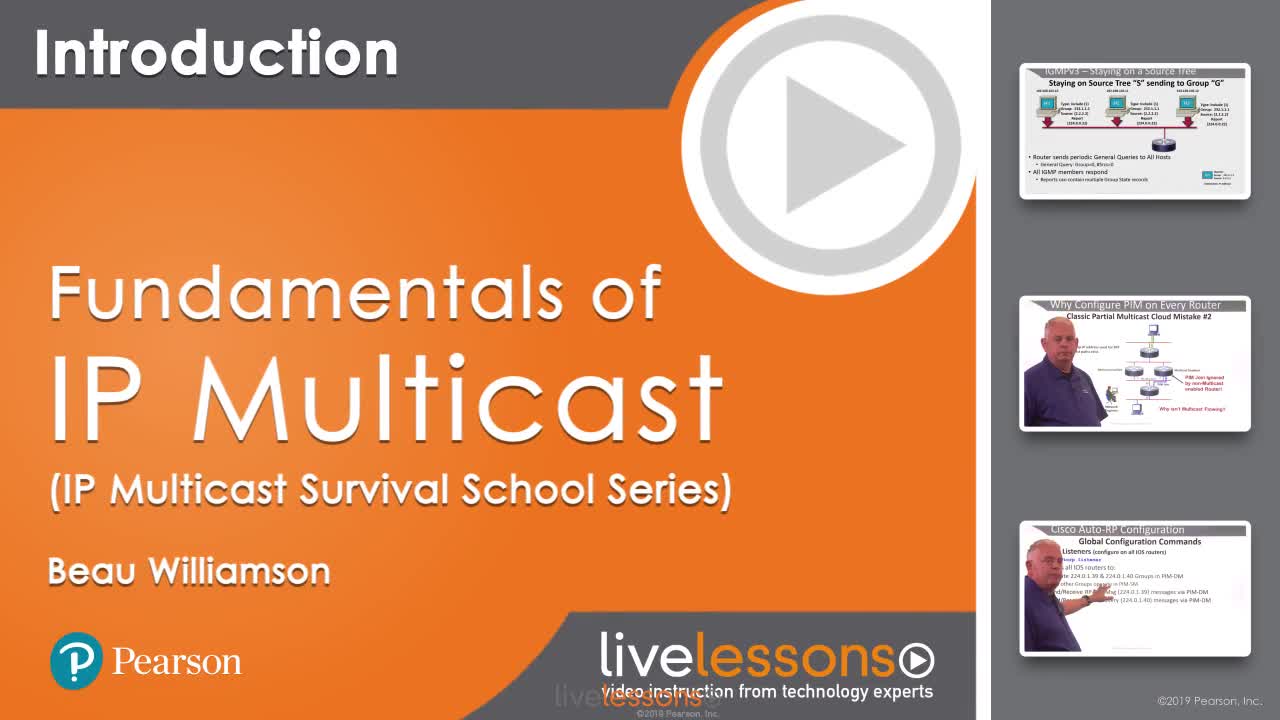Fundamentals of IP Multicast (IP Multicast Survival School Series) LiveLessons
- By Beau Williamson
- Published Oct 8, 2018 by Cisco Press. Part of the LiveLessons series.
- Copyright 2019
- Edition: 1st
- Online Video
- ISBN-10: 0-13-524063-8
- ISBN-13: 978-0-13-524063-2
Register your product to gain access to bonus material or receive a coupon.
5+ Hours of Video Instruction
More than 5 hours of video instruction to help you understand, deploy, and manage, basic IP Multicast networks.
Overview
Fundamentals of IP Multicast provides the Network Engineer with a basic set of IP Multicast “survival tools” to go alone and unafraid into the world of IP Multicast and deal with much of what IP Multicast throws at them.
Award-winning IP Multicast presenter, Beau Williamson, debunks the myth that IP Multicast is a scary and difficult-to-understand technology. Through network topology presentations, configuration scenarios, guidance through some common mistakes that network engineers make, deployment recommendations, and know-how, Beau paints IP Multicast as an approachable networking solution.
Skill Level
- Intermediate
Learn How To
- Map IPv4 MAC addresses
- Implement Multicast forwarding, routing, and tree building
- Comprehend the IGMPv3 protocol with a focus on joining, staying on, and leaving a source Multicast tree
- Configure and deploy Source Specific Multicast (SSM) in your network
- Understand and configure Bidirectional (BiDir) Multicast in your network
- Understand and configure Any-Source Multicast (ASM) in your network
- Comprehend Multiprotocol BGP (MP-BGP), Multicast Source Discovery Protocol (MSDP), and basic interdomain Multicast Forwarding
- Understand Cisco Auto-RP, IETF Bootstrap Router (BSR), Anycast-RP options
- Comprehend Bit-Indexed Explicit Replication (BIER) concepts and forwarding
- Understand IPv6 Multicast Addressing, Listener Discovery, and RP Choices
Who Should Take This Course
- Networking professionals who want to enhance their skillsets with a working knowledge of how IP Multicast works
- Network engineers seeking to implement IP Multicast in their network
Course Requirements
- Requires basic knowledge of networking and network configuration
Table of Contents
Introduction
Lesson 1: A Brief Overview of IP Multicast
Lesson 2: Multicast Addressing
Lesson 3: Multicast Fundamentals
Lesson 4: Host-Router Signaling
Lesson 5: Source Specific Multicast (SSM)
Lesson 6: Bidirectional Multicast (BiDir)
Lesson 7: Any-Source Multicast (ASM)
Lesson 8: Inter-Domain Multicast
Lesson 9: ASM Redundant RP Choices
Lesson 10: Bit-Indexed Explicit Replication (BIER)
Lesson 11: IPv6 Multicast
Summary
Lesson Descriptions
Lesson 1 kicks off with a history lesson of the justification for why Multicast was created, before moving on to an examination of flood and prune protocols, and an exploration of explicit signaling protocols. It wraps up with a look at some of the characteristics of IP Multicast.
Lesson 2 provides coverage of IPv4 Multicast addresses and how they map to Layer 2 to become Multicast MAC-layer addresses.
Lesson 3 covers the fundamentals of IP Multicast, including forwarding, routing, and tree building.
Lesson 4 explores the IGMPv3 protocol before moving on to a look at how hosts join, stay on, and leave a source Multicast tree. The lesson wraps up with a comparison of the previous IGMP versions as well as an exploration of IGMP snooping technology.
Lesson 5 introduces SSM with a review of the origins of PIM-SSM, before moving on to a look at the fundamentals of SSM and how to configure SSM in your network. The lesson concludes with an examination of barriers to SSM deployment and how to use and configure SSM mapping to mitigate those barriers.
Lesson 6 begins by exploring basic BiDir Multicast concepts before moving on to coverage of BiDir shared trees. Finally, the lesson concludes with coverage of how to configure BiDir Multicast in your network.
Lesson 7 examines what makes Multicast difficult for network engineers, before shifting to coverage of ASM concepts and how to configure a simple ASM network.
Lesson 8 reviews the history of Inter-Domain Multicast before diving briefly into MP-BGP and MSDP, and concluding with a look at how Inter-Domain Multicast Forwarding operates.
Lesson 9 explores Cisco Auto-RP, IETF BSR, Anycast-RP using MSDP, as well as Anycast-RP using PIM.
Lesson 10 reviews the origins of the BIER multicast model, before diving in behind the basic concepts behind BIER, and concludes with a look at how BIER works in a Multicast domain
Lesson 11 wraps up the course with an exploration of IPv6 Multicast addressing, listener discovery, RP choices, and contrasts between IPv4 and IPv6 Multicast.
About Pearson Video Training
Pearson publishes expert-led video tutorials covering a wide selection of technology topics designed to teach you the skills you need to succeed. These professional and personal technology videos feature world-leading author instructors published by your trusted technology brands: Addison-Wesley, Cisco Press, Pearson IT Certification, Prentice Hall, Sams, and Que Topics include: IT Certification, Network Security, Cisco Technology, Programming, Web Development, Mobile Development, and more. Learn more about Pearson Video training at http://www.informit.com/video.
Video Lessons are available for download for offline viewing within the streaming format. Look for the green arrow in each lesson.
Table of Contents
Introduction
Lesson 1: A Brief Overview of IP Multicast
Lesson 2: Multicast Addressing
Lesson 3: Multicast Fundamentals
Lesson 4: Host-Router Signaling
Lesson 5: Source Specific Multicast (SSM)
Lesson 6: Bidirectional Multicast (BiDir)
Lesson 7: Any-Source Multicast (ASM)
Lesson 8: Inter-Domain Multicast
Lesson 9: ASM Redundant RP Choices
Lesson 10: Bit-Indexed Explicit Replication (BIER)
Lesson 11: IPv6 Multicast
Summary
Online Video
- Your Price: $159.99
- List Price: $199.99
- About this video
Video accessible from your Account page after purchase.
